Mechanical Strength Evaluation of Elastic Materials by Multiphysical Nondestructive Methods: A Review
Abstract
:1. Introduction
2. Noncontact Mechanical Property Testing Methods
2.1. Optical/Radiation Techniques
2.2. Photoacoustic (PA) Techniques
2.3. Photothermal (PT) Techniques
3. Conclusions
Author Contributions
Funding
Acknowledgments
Conflicts of Interest
References
- Sposito, G.; Ward, C.; Cawley, P.; Nagy, P.B.; Scruby, C. A review of non-destructive techniques for the detection of creep damage in power plant steels. NDT&E Int. 2010, 43, 555–567. [Google Scholar]
- Breysse, D. Nondestructive evaluation of concrete strength: An historical review and a new perspective by combining NDT methods. Constr. Build. Mater. 2012, 33, 139–163. [Google Scholar] [CrossRef]
- Kamsu-Foguem, B. Knowledge-based support in Non-Destructive Testing for health monitoring of aircraft structures. Adv. Eng. Inform. 2012, 26, 859–869. [Google Scholar] [CrossRef] [Green Version]
- Hola, J.; Schabowicz, K. State-of-the-art non-destructive methods for diagnostic testing of building structures—Anticipated development trends. Arch. Civ. Mech. Eng. 2010, 10, 5–18. [Google Scholar] [CrossRef]
- Hola, J.; Beiń, J.; Sadowski, L.; Schabowicz, K. Non-destructive and semi-destructive diagnostics of concrete structures in assessment of their durability. Civ. Eng. 2015, 63, 87–96. [Google Scholar]
- Ibrahim, M.E. Nondestructive evaluation of thick-section composites and sandwich structures: A review. Compos. Part A-Appl. Sci. Manuf. 2014, 64, 36–48. [Google Scholar] [CrossRef]
- Duchene, P.; Chaki, S.; Ayadi, A.; Krawczak, P. A review of non-destructive techniques used for mechanical damage assessment in polymer composites. J. Mater. Sci. 2018, 53, 7915–7938. [Google Scholar] [CrossRef]
- Burte, H.M. A science base for NDE and its coupling to technology. In International Advances in Nondestructive Testing; McGonnagle, W.J., Ed.; CRC Press: Boca Raton, FL, USA, 1979; Volume 6, pp. 19–38. [Google Scholar]
- Adams, R.D.; Cawley, P. A review of defect types and nondestructive testing techniques for composites and bonded joints. NDT&E Int. 1988, 21, 208–222. [Google Scholar]
- Malhotra, V.M.; Carino, N.J. Handbook on Nondestructive Testing of Concrete; CRC Press: Boca Raton, FL, USA, 2003; pp. 1–13. [Google Scholar]
- Harding, J.; Wood, E.O.; Campbell, J.D. Tensile testing of materials at impact rates of strain. J. Mech. Eng. Sci. 1960, 2, 88–96. [Google Scholar] [CrossRef]
- Ramberg, W.; Osgood, W.R. Description of Stress-Strain Curves by Three Parameters; National Advisory Committee for Aeronautics Technical Note; NACA-TN-902; National Advisory Committee for Aeronautics: Washington, DC, USA, 1943. [Google Scholar]
- Hill, H.N. Determination of Stress-Strain Relations from “Offset” Yield Strength Values; National Advisory Committee for Aeronautics Technical Note; NACA-TN-927; National Advisory Committee for Aeronautics: Washington, DC, USA, 1944. [Google Scholar]
- McCullough, K.Y.G.; Fleck, N.A.; Ashby, M.F. Uniaxial stress-strain behaviour of aluminium alloy foams. Acta Mater. 1999, 47, 2323–2330. [Google Scholar] [CrossRef]
- Ling, Y. Uniaxial true stress-strain after necking. AMP J. Technol. 1996, 5, 37–48. [Google Scholar]
- Turner, R.C.; Fuierer, P.A.; Newnham, R.E.; Shrout, T.R. Materials for high temperature acoustic and vibration sensors: A review. Appl. Acoust. 1994, 41, 299–324. [Google Scholar] [CrossRef]
- Cegla, F.B.; Cawley, P.; Allin, J.; Davies, J. High-temperature (>500 °C) wall thickness monitoring using dry-coupled ultrasonic waveguide transducers. IEEE Trans. Ultrason. Ferroelectr. Freq. Control 2011, 58, 156–167. [Google Scholar] [CrossRef] [PubMed]
- Kobayashi, M.; Jen, C.K.; Bussiere, J.F.; Wu, K.T. High-temperature integrated and flexible ultrasonic transducers for nondestructive testing. NDT&E Int. 2009, 42, 157–161. [Google Scholar]
- Liu, Z.; Wu, H.; Paterson, A.; Luo, Z.; Ren, W.; Ye, Z.G. High Curie-temperature (TC) piezo-/ferroelectric single crystals with bismuth-based complex perovskites: Growth, structures and properties. Acta Mater. 2017, 136, 32–38. [Google Scholar] [CrossRef]
- Lyons, J.S.; Liu, J.; Sutton, M.A. High-temperature deformation measurements using digital-image correlation. Exp. Mech. 1996, 36, 64–70. [Google Scholar] [CrossRef]
- Anwander, M.; Zagar, B.G.; Weiss, B.; Weiss, H. Noncontacting strain measurements at high temperature by the digital laser speckle technique. Exp. Mech. 2000, 40, 98–105. [Google Scholar] [CrossRef]
- Vǒlkl, R.; Fischer, B. Mechanical testing of ultra-high temperature alloys. Exp. Mech. 2004, 44, 121–127. [Google Scholar] [CrossRef]
- Zhu, D.; Mobasher, B.; Rajan, S.D. Non-contacting strain measurement for cement-based composites in dynamic tensile testing. Cem. Concr. Compos. 2012, 34, 147–155. [Google Scholar] [CrossRef]
- Wolverton, M.; Bhattacharyya, A.; Kannarpady, G.K. Efficient, flexible, noncontact deformation measurements using video multi-extensometry. Exp. Tech. 2009, 33, 24–33. [Google Scholar] [CrossRef]
- Pan, B.; Wu, D.; Wang, Z.; Xia, Y. High-temperature digital image correlation method for full-field deformation measurement at 1200 °C. Meas. Sci. Technol. 2011, 22, 015701. [Google Scholar] [CrossRef]
- Pan, B.; Qian, K.; Xie, H.; Asundi, A. Two-dimensional digital image correlation for in-plane displacement and strain measurement: A review. Meas. Sci. Technol. 2009, 20, 062001. [Google Scholar] [CrossRef]
- Yang, X.; Liu, Z.; Xie, H. A real time deformation evaluation method for surface and interface of thermal barrier coatings during 1100 °C thermal shock. Meas. Sci. Technol. 2012, 23, 105604. [Google Scholar] [CrossRef]
- Hoła, J.; Sadowski, Ł.; Reiner, J.; Stach, S. Usefulness of 3D surface roughness parameters for nondestructive evaluation of pull-off adhesion of concrete layers. Constr. Build. Mater. 2015, 84, 111–120. [Google Scholar] [CrossRef]
- Czarnecki, S.; Hoła, J. Evaluation of the height 3D roughness parameters of concrete substrate and the adhesion to epoxy resin. Int. J. Adhes. Adhes. 2016, 67, 3–13. [Google Scholar]
- Sadowski, Ł. Non-destructive identification of pull-off adhesion between concrete layers. Automat. Constr. 2015, 57, 146–155. [Google Scholar] [CrossRef]
- Barrett, C.S.; Predecki, P. Stress measurement in graphite/epoxy uniaxial composites by X-ray. Polym. Compos. 1980, 1, 2–6. [Google Scholar] [CrossRef]
- Ledbetter, H.M.; Austin, M.W. Internal strain (stress) in an SiC-Al particle-reinforced composite: An X-ray diffraction study. Mater. Sci. Eng. 1987, 89, 53–61. [Google Scholar] [CrossRef]
- Hemley, R.J.; Mao, H.; Shen, G.; Badro, J.; Gillet, P.; Hanfland, M.; Häusermann, D. X-ray imaging of stress and strain of diamond, iron, and tungsten at megabar pressures. Science 1997, 276, 1242–1245. [Google Scholar] [CrossRef] [Green Version]
- Prevey, P.S. X-ray diffraction residual stress techniques. ASM Handb. 1986, 10, 380–392. [Google Scholar]
- Hughes, D.J.; Mahendrasingam, A.; Martin, C.; Oatway, M.B.; Heeley, E.L.; Bingham, S.J.; Fuller, W. An instrument for the collection of simultaneous small and wide angle X-ray scattering and stress–strain data during deformation of polymers at high strain rates using synchrotron radiation sources. Rev. Sci. Instrum. 1999, 70, 4051–4054. [Google Scholar] [CrossRef]
- Patterson, B.M.; Cordes, N.L.; Henderson, K.; Williams, J.J.; Stannard, T.; Singh, S.S.; Ovejero, A.R.; Xiao, X.; Robinson, M.; Chawla, N. In situ X-ray synchrotron tomographic imaging during the compression of hyper-elastic polymeric materials. J. Mater. Sci. 2016, 51, 171–187. [Google Scholar] [CrossRef]
- Fieres, J.; Schumann, P.; Reinhart, C. Predicting failure in additively manufactured parts using X-ray computed tomography and simulation. Procedia Eng. 2018, 213, 69–78. [Google Scholar] [CrossRef]
- Subramanian, J.; Seetharaman, S.; Gupta, M. Processing and properties of aluminum and magnesium based composites containing amorphous reinforcement: A review. Metals 2015, 5, 743–762. [Google Scholar] [CrossRef] [Green Version]
- Xing, J.; Zhao, C.; Yu, S.; Matsuda, H.; Ma, C. Experimental study on rock-like specimens with single flaw under hydro-mechanical coupling. Appl. Sci. 2019, 9, 3234. [Google Scholar] [CrossRef] [Green Version]
- Youssef, S.; Marie, E.; Gaertner, R. Finite element modelling of the actual structure of cellular materials determined by X-ray tomography. Acta Mater. 2005, 53, 710–730. [Google Scholar] [CrossRef]
- Bell, A.G. On the production and reproduction of sound by light. Am. J. Sci. 1880, 20, 305–324. [Google Scholar] [CrossRef] [Green Version]
- Scruby, C.B.; Dewhurst, R.J.; Hutchins, D.A.; Palmer, B. Quantitative studies of thermally generated elastic waves in laser-irradiated metals. J. Appl. Phys. 1981, 51, 6210–6216. [Google Scholar] [CrossRef]
- Rose, L.R.F. Point-source representation for laser-generated ultrasound. J. Acoust. Soc. Am. 1984, 75, 723–732. [Google Scholar] [CrossRef]
- Hutchins, D.A. Mechanisms of pulsed photoacoustic generation. Can. J. Phys. 1986, 64, 1247–1264. [Google Scholar] [CrossRef]
- Biot, M.A. The influence of initial stress on elastic waves. J. Appl. Phys. 1940, 11, 522–530. [Google Scholar] [CrossRef]
- Hughes, D.S.; Kelly, J.L. Second-order elastic deformation of solids. Phys. Rev. 1953, 92, 1145–1149. [Google Scholar] [CrossRef]
- Bergman, R.H.; Shahbender, R.A. Effect of statically applied stresses on the velocity of propagation of ultrasonic waves. J. Appl. Phys. 1958, 29, 1736–1738. [Google Scholar] [CrossRef]
- Tokuoka, T.; Saito, M. Elastic wave propagations and acoustical birefringence in stressed crystals. J. Acoust. Soc. Am. 1968, 45, 1241–1246. [Google Scholar] [CrossRef]
- Husson, D.; Kino, G.S. A perturbation theory for acoustoelastic effects. J. Appl. Phys. 1982, 53, 7250–7258. [Google Scholar] [CrossRef]
- Shams, M.; Destrade, M.; Ogden, R.W. Initial stresses in elastic solids: Constitutive laws and acoustoelasticity. Wave Motion 2011, 48, 552–567. [Google Scholar] [CrossRef] [Green Version]
- Davies, G.F. Quansi-harmonic finite strain equations of state of solids. J. Phys. Chem. Solids 1973, 34, 1417–1429. [Google Scholar] [CrossRef]
- Murnaghan, F.D. Finite deformations of an elastic solid. Am. J. Math. 1937, 59, 235–260. [Google Scholar] [CrossRef]
- Tylczyński, Z.; Mróz, B. The influence of uniaxial stress on ultrasonic wave propagation in ferroelastic (NH4)4LiH3(SO4)4. Solid State Commun. 1997, 101, 653–656. [Google Scholar] [CrossRef]
- Chaki, S.; Bourse, G. Guided ultrasonic waves for non-destructive monitoring of the stress levels in prestressed steel strands. Ultrasonics 2009, 49, 162–171. [Google Scholar] [CrossRef]
- Gennisson, J.L.; Renier, M.; Catheline, S.; Barriere, C.; Bercoff, J.; Tanter, M.; Fink, M. Acoustoelasticity in soft solids: Assessment of the nonlinear shear modulus with the acoustic radiation force. J. Acoust. Soc. Am. 2007, 122, 3211–3219. [Google Scholar] [CrossRef] [PubMed]
- Iwashimizu, Y.; Kobori, O. The Rayleigh wave in a finitely deformed isotropic elastic material. J. Acoust. Soc. Am. 1978, 64, 910–916. [Google Scholar] [CrossRef]
- Duquennoy, M.; Ouaftouh, M.; Deboucq, J.; Lefebvre, J.E.; Jenot, F.; Ourak, M. Influence of a superficial field of residual stress on the propagation of surface waves—Applied to the estimation of the depth of the superficial stressed zone. Appl. Phys. Lett. 2012, 101, 234104. [Google Scholar] [CrossRef]
- Duquennoy, M.; Ouaftouh, M.; Ourak, M.; Jenot, F. Theoretical determination of Rayleigh wave acoustoelastic coefficients: Comparison with experimental values. Ultrasonics 2002, 39, 575–583. [Google Scholar] [CrossRef]
- Kasai, M.; Sawada, T. Non-destructive evaluation of the distribution of stress by means of the photoacoustic microscope. In Photoacoustic and Photothermal Phenomena II; Murphy, J.C., Maclachlan Spicer, J.W., Aamodt, L.C., Royce, B.S.H., Eds.; Springer: Berlin, Germany, 1990; pp. 33–36. [Google Scholar]
- Muratikov, K.L.; Glazov, A.L.; Rose, D.N.; Dumar, J.E. Photoacoustic effect in stressed elastic solids. J. Appl. Phys. 2000, 88, 1948–2955. [Google Scholar] [CrossRef]
- Muratikov, K.L. Theory of stress influence on the photoacoustic thermoelastic signal near the vertical crack tips. Rev. Sci. Instrum. 2003, 74, 722–724. [Google Scholar] [CrossRef]
- Muratikov, K.L. Theory of the generation of mechanical vibrations by laser radiation in solids containing internal stresses on the basis of the thermoelastic effect. Tech. Phys. 1999, 44, 792–796. [Google Scholar] [CrossRef]
- Keller, J.B. Finite elastic deformation governed by linear equations. J. Appl. Mech. 1986, 53, 819–820. [Google Scholar] [CrossRef]
- Huan, H.; Mandelis, A.; Lashkari, B.; Liu, L. Frequency-domain laser ultrasound (FDLU) non-destructive evaluation of stress-strain behavior in an aluminum alloy. Int. J. Thermophys. 2017, 38, 62. [Google Scholar] [CrossRef]
- Sun, G.; Zhou, Z. Non-contact detection of delamination in layered anisotropic composite materials with ultrasonic waves generated and detected by lasers. Optik 2016, 127, 6424–6433. [Google Scholar] [CrossRef]
- Karabutov, A.; Devichensky, A.; Ivochkin, A.; Lyamshev, M.; Pelivanov, I.; Rohdgi, U.; Solomatin, V.; Subudhi, M. Laser ultrasonic diagnostics of residual stress. Ultrasonics 2008, 48, 631–635. [Google Scholar] [CrossRef] [PubMed]
- McDonald, W.F.; Goettler, H.; Urban, M.W. A novel approach to photoacoustic FT-IR spectroscopy: Rheo-photoacoustic measurements. Appl. Spectrosc. 1989, 43, 1387–1393. [Google Scholar] [CrossRef]
- Liu, L.; Mandelis, A.; Huan, H.; Melnikov, A. Step-scan T cell-based differential Fourier transform infrared photoacoustic spectroscopy (DFTIR-PAS) for detection of ambient air contaminants. Appl. Phys. B 2016, 122, 268. [Google Scholar] [CrossRef]
- Liu, L.; Mandelis, A.; Huan, H.; Michaelian, K.H. Step-scan differential Fourier transform infrared photoacoustic spectroscopy (DFTIR-PAS): A spectral deconvolution method for weak absorber detection in the presence of strongly overlapping background absorptions. Opt. Lett. 2017, 42, 1424–1427. [Google Scholar] [CrossRef] [PubMed]
- Qian, M. New thermoelastic technique for detection of residual stress distribution in solids. Acta Acust. 1995, 14, 97–106, (Chinese Version). [Google Scholar]
- Landau, L.D.; Lifshitz, E.M. Theory of Elasticity; Pergamon: Oxford, UK, 1959; pp. 119–121. [Google Scholar]
- Love, A.E.H. A Treatise on the Mathematical Theory of Elasticity, 2nd ed.; Cambridge University Press: Cambridge, UK, 1906; pp. 90–107. [Google Scholar]
- Wong, A.K.; Jones, R.; Sparrow, J.G. Thermoelastic constant or thermoelastic parameter? J. Phys. Chem. Solids 1987, 48, 749–753. [Google Scholar] [CrossRef]
- Wong, A.K.; Sparrow, J.G.; Dunn, S.A. On the revised theory of the thermoelastic effect. J. Phys. Chem. Solids 1988, 49, 395–400. [Google Scholar] [CrossRef]
- Belgen, M.H. Structural stress measurements with an infrared radiometer. ISA Trans. 1967, 6, 49–53. [Google Scholar]
- Stanley, P.; Chan, W.K. Quantitative stress analysis by means of the thermoelastic effect. J. Strain Anal. Eng. 1985, 20, 129–137. [Google Scholar] [CrossRef]
- Wong, A.K.; Dunn, S.A.; Sparrow, J.G. Residual stress measurement by means of the thermoelastic effect. Nature 1988, 332, 613–615. [Google Scholar] [CrossRef]
- Gyekenyesi, A.L.; Baaklini, G.Y. Thermoelastic stress analysis: The mean stress effect in metallic alloys. In Proceedings of the Nondestructive Evaluation Techniques for Aging Infrastructures and Manufacturing, Newport Beach, CA, USA, 3–5 March 1999. NASA/TM-1999-209376. [Google Scholar]
- Quinn, S.; Dulieu-Barton, J.M.; Langlands, J.M. Progress in thermoelastic residual stress measurement. Strain 2004, 40, 127–133. [Google Scholar] [CrossRef]
- Menczel, J.D.; Prime, R.B. Thermal Analysis of Polymers Fundamentals and Applications; John Wiley & Sons: Hoboken, NJ, USA, 2009; pp. 384–495. [Google Scholar]
- Zhang, H.; Sfarra, S.; Sarasini, F.; Santulli, C.; Fernandes, H.; Avdelidis, N.P.; Ibarra-Castanedo, C.; Maldague, X.P.V. Thermographic non-destructive evaluation for natural fiber-reinforced composite laminates. Appl. Sci. 2018, 8, 240. [Google Scholar] [CrossRef] [Green Version]
- Liu, J.; Gong, J.; Liu, L.; Qin, L.; Wang, Y. Investigation on stress distribution of multilayered composite structure (MCS) using infrared thermographic technique. Infrared Phys. Technol. 2013, 61, 134–143. [Google Scholar] [CrossRef]
- Huan, H.; Mandelis, A.; Liu, L. Characterization of the mechanical stress–strain performance of aerospace alloy materials using frequency-domain photoacoustic ultrasound and photothermal methods: An FEM approach. Int. J. Thermophys. 2018, 39, 55. [Google Scholar] [CrossRef]
- Huan, H.; Mandelis, A.; Liu, L.; Melnikov, A. Local-stress-induced thermal conductivity anisotropy analysis using non-destructive photo-thermo-mechanical lock-in thermography (PTM-LIT) imaging. NDT&E Int. 2017, 91, 79–87. [Google Scholar]
- Salazar, A.; Sanchez-Lavega, A.; Ocariz, A.; Guitonny, J.; Pandey, G.C.; Fournier, D.; Boccara, A.C. Thermal diffusivity of anisotropic materials by photothermal methods. J. Appl. Phys. 1996, 79, 3984–3993. [Google Scholar] [CrossRef]
- Iravani, M.V.; Nikoonahad, M. Photothermal waves in anisotropic media. J. Appl. Phys. 1987, 62, 4065–4071. [Google Scholar] [CrossRef]
- Long, F.H.; Anderson, R.R.; Deutsch, T.F. Pulsed photothermal radiometry for depth profiling of layered media. Appl. Phys. Lett. 1987, 51, 2076–2078. [Google Scholar] [CrossRef]
- Prahl, S.A.; Vitkin, I.A.; Bruggemann, U.; Wilson, B.C.; Aderson, R.R. Determination of optical properties of turbid media using pulsed photothermal radiometry. Phys. Med. Biol. 1992, 37, 1203–1217. [Google Scholar] [CrossRef]
- Milner, T.E.; Smithies, D.J.; Goodman, D.M.; Lau, A.; Nelson, J.S. Depth determination of chromophores in human skin by pulsed photothermal radiometry. Appl. Opt. 1996, 35, 3379–3385. [Google Scholar] [CrossRef]
- Milner, T.E.; Katzir, A.; Jacques, S.L. Pulsed photothermal radiometry of port-wine stains. Proc. SPIE 1993, 1882, 34–42. [Google Scholar]
- Busse, G.; Wu, D.; Karpen, W. Thermal wave imaging with phase sensitive modulated thermography. J. Appl. Phys. 1992, 71, 3962–3965. [Google Scholar] [CrossRef]
- Mandelis, A.; Abrams, S.H.; Nicolaides, L.; Garcia, J.A. Method and Apparatus for Detection of Defects in Teeth. U.S. Patent US6584341, 24 June 2003. [Google Scholar]
- Wang, C.; Mandelis, A.; Liu, Y. Thermal-wave nondestructive evaluation of cylindrical composite structures using frequency-domain photothermal radiometry. J. Appl. Phys. 2005, 97, 014911. [Google Scholar] [CrossRef] [Green Version]
- Balderas-López, J.A.; Mandelis, A.; Garcia, J.A. Thermal-wave resonator cavity design and measurements of the thermal diffusivity of liquids. Rev. Sci. Instrum. 2000, 71, 2933–2937. [Google Scholar] [CrossRef]
- Yarai, A.; Yokoyama, Y.; Nakanishi, T. New non-destructive photothermal measurement of anisotropically distributed residual stress inside samples. In Proceedings of the IEEE Ultrasonics Symposium, Cannes, France, 31 October–3 November 1994; pp. 683–686. [Google Scholar]
- Pron, H.; Henry, J.F.; Offermann, S.; Bissieux, C.; Beaudoin, J.L. Analysis of stress influence on thermal diffusivity by photothermal infrared thermography, Estimation of local thermophysical properties by means of front-face photothermal infrared thermography: Application to mechanical stress analysis. High Temp.-High Press. 2000, 32, 473–477. [Google Scholar] [CrossRef]
- Pron, H.; Bissieux, C. 3-D thermal modelling applied to stress-induced anisotropy of thermal conductivity. Int. J. Therm. Sci. 2004, 43, 1161–1169. [Google Scholar] [CrossRef]
- Paoloni, S.; Tata, M.E.; Scudieri, F.; Mercuri, F.; Marinelli, M.; Zammit, U. IR thermography characterization of residual stress in plastically deformed metallic components. Appl. Phys. A 2010, 98, 461–465. [Google Scholar] [CrossRef]
- Mzali, F.; Albouchi, F.; Nasrallah, S.B.; Petit, D. Optimal experiment design and thermo-physical characterization of a plastically deformed solid. Inverse Probl. Sci. Eng. 2009, 17, 335–345. [Google Scholar] [CrossRef]
- Huan, H.; Mandelis, A.; Liu, L.; Melnikov, A. Non-destructive and non-contacting stress-strain characterization of aerospace metallic alloys using photo-thermo-mechanical radiometry. NDT&E Int. 2016, 84, 47–53. [Google Scholar]
- Wang, Y.; Wright, N.T. A relationship between thermal diffusivity and finite deformation in polymers. Int. J. Thermophys. 2005, 26, 1849–1859. [Google Scholar] [CrossRef]
- Huan, H.; Mandelis, A.; Liu, L.; Melnikov, A. Evaluation of mechanical performance of NiCo nanocoated aerospace aluminum alloy using quantitative photo-thermo-mechanical radiometry as a non-contact strain gauge. NDT&E Int. 2017, 87, 44–49. [Google Scholar]
- Tai, R.; Zhang, J.; Wang, C.; Mandelis, A. Thermal-Wave Fields in Solid Wedges Using the Green Function Method: Theory and Experiment. J. Appl. Phys. 2013, 113, 133501. [Google Scholar] [CrossRef] [Green Version]
- Liu, L.; Wang, C.; Yuan, X.; Mandelis, A. Curvature-insensitive methodology for thermal-wave depth-profilometry in curvilinear solids. J. Phys. D-Appl. Phys. 2010, 43, 285403. [Google Scholar] [CrossRef]
- Celorrio, R.; Mendioroz, A.; Apiñaniz, E.; Salazar, A.; Wang, C.; Mandelis, A. Reconstruction of radial thermal conductivity depth profile in case hardened steel rods. J. Appl. Phys. 2009, 105, 083517. [Google Scholar] [CrossRef]
- Zhang, J.; Xie, G.; Wang, C.; Mandelis, A. Laser induced thermal-wave fields in multi-layered spherical solids based on Green function method. J. Appl. Phys. 2012, 112, 033521. [Google Scholar] [CrossRef]
- Wang, M.; Mandelis, A.; Melnikov, A.; Wang, C. Quantitative lock-in thermography imaging of thermal-wave spatial profiles and thermophysical property measurements in solids with inner corner geometries using thermal-wave field theory. J. Appl. Phys. 2018, 124, 205106. [Google Scholar] [CrossRef]

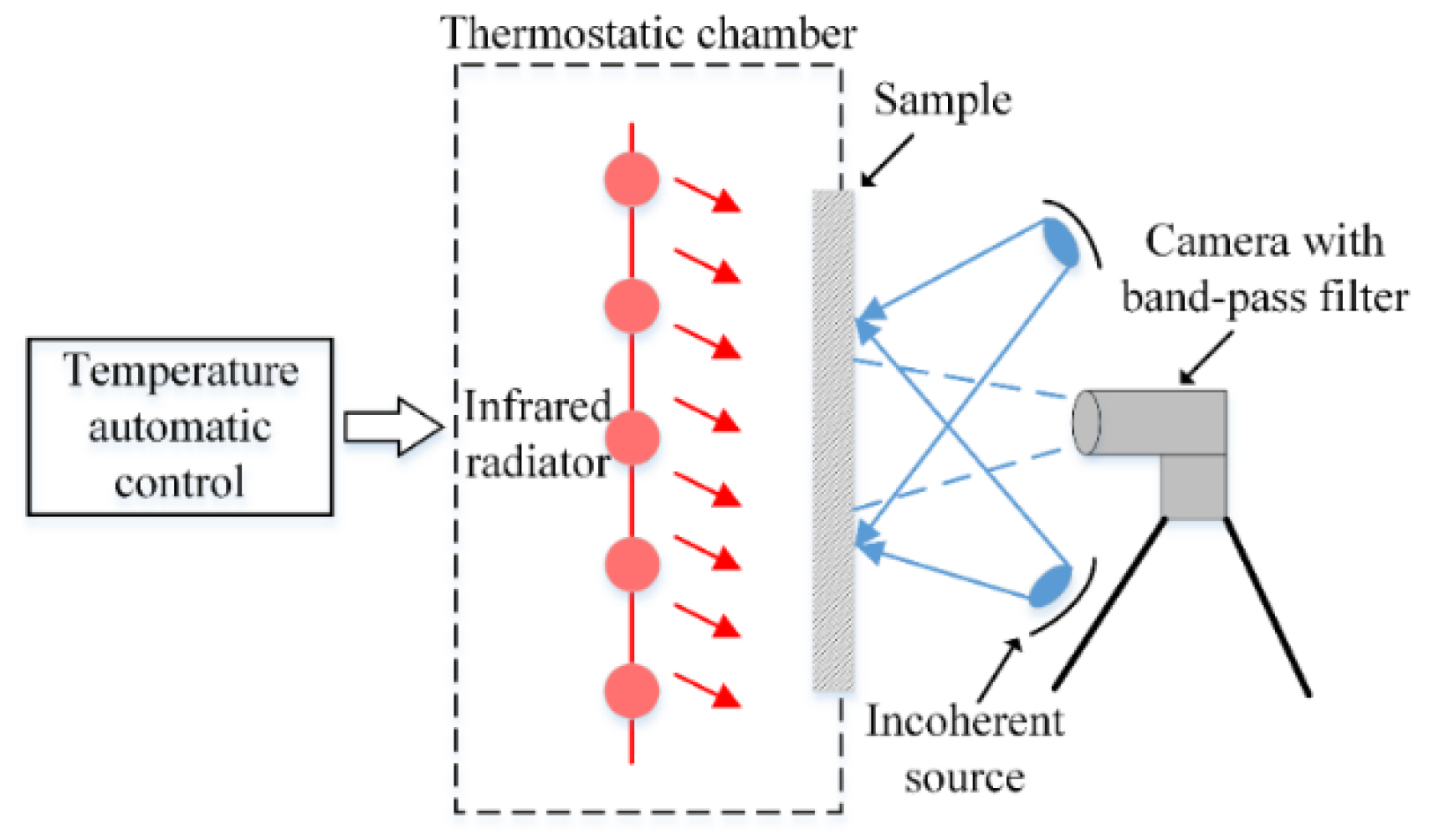
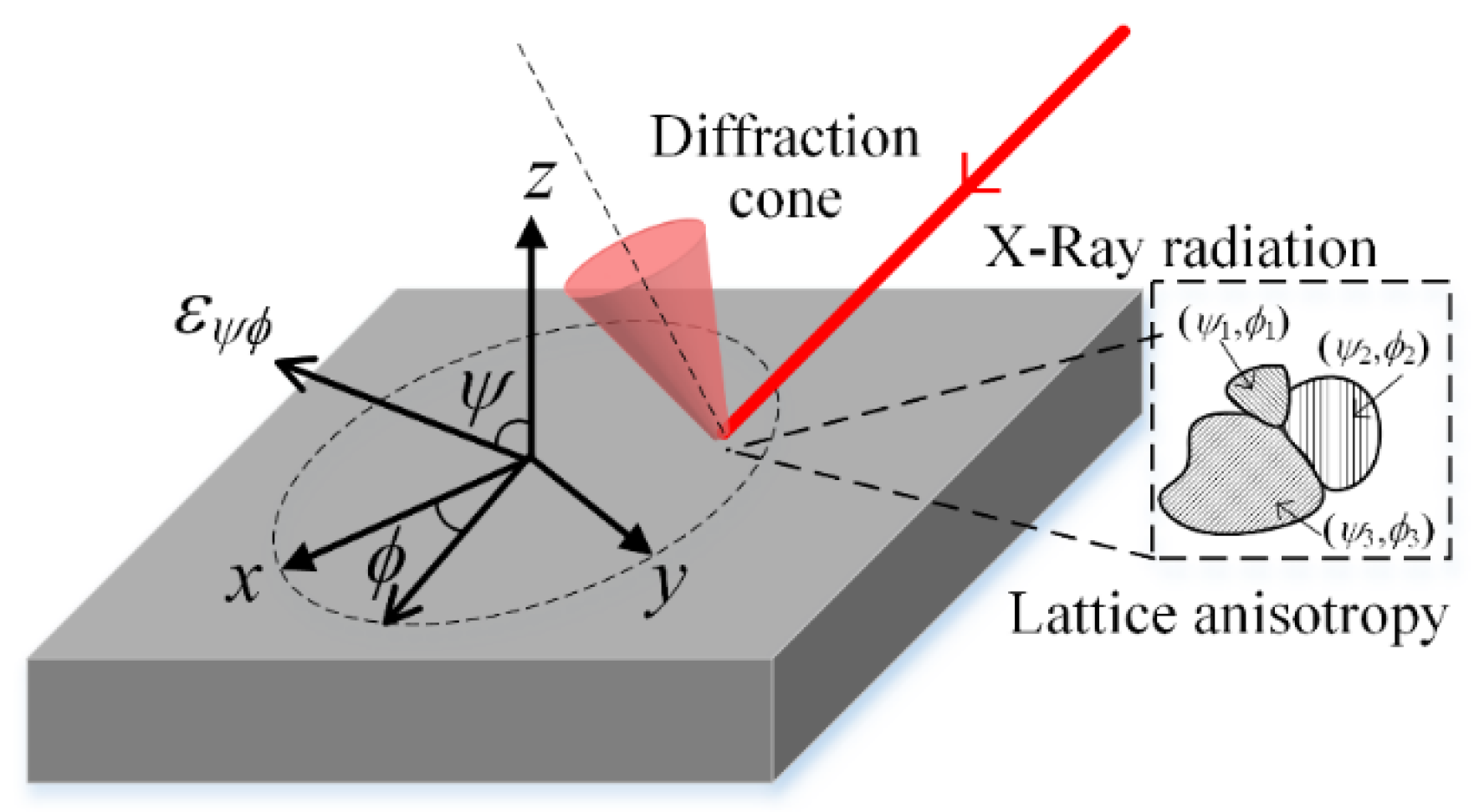
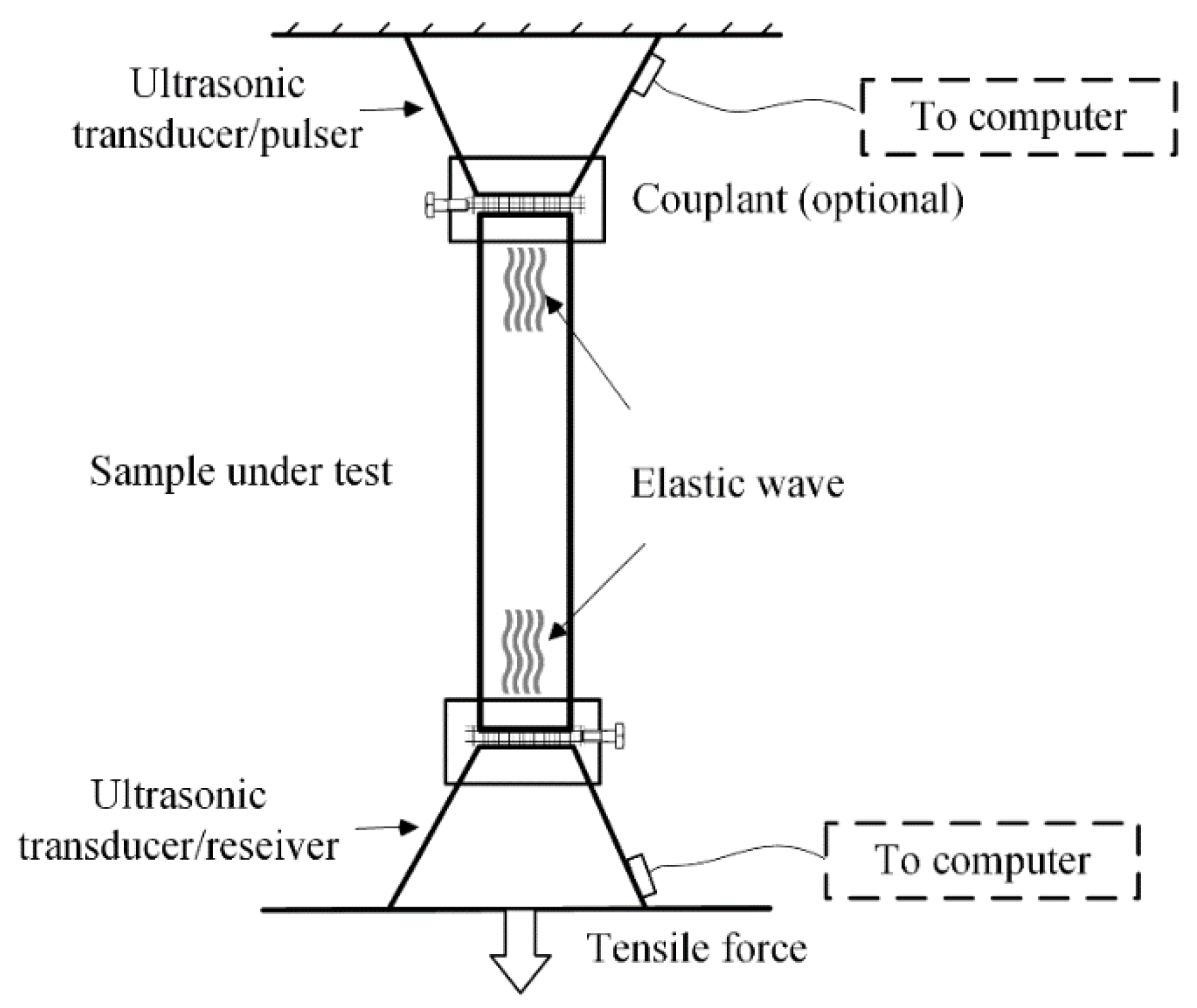
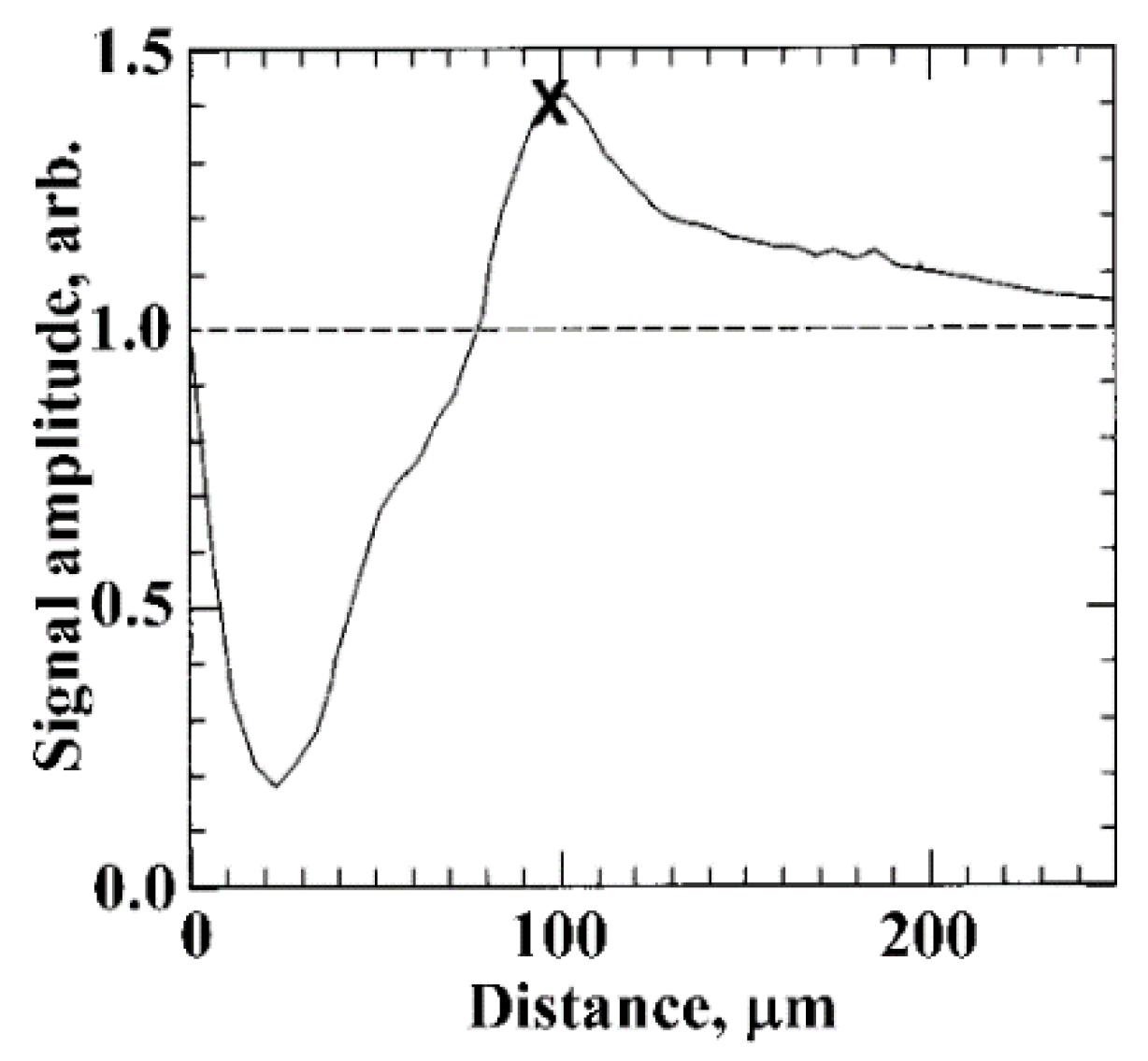
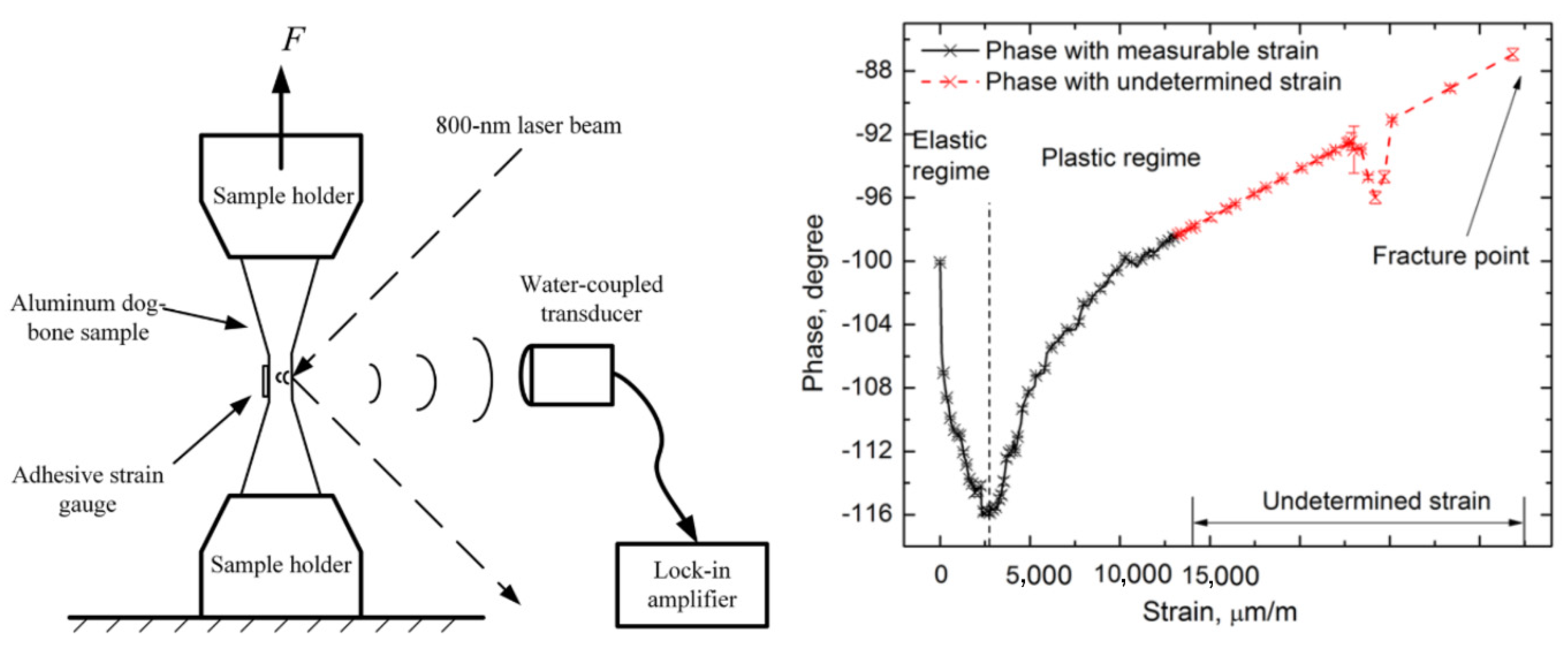
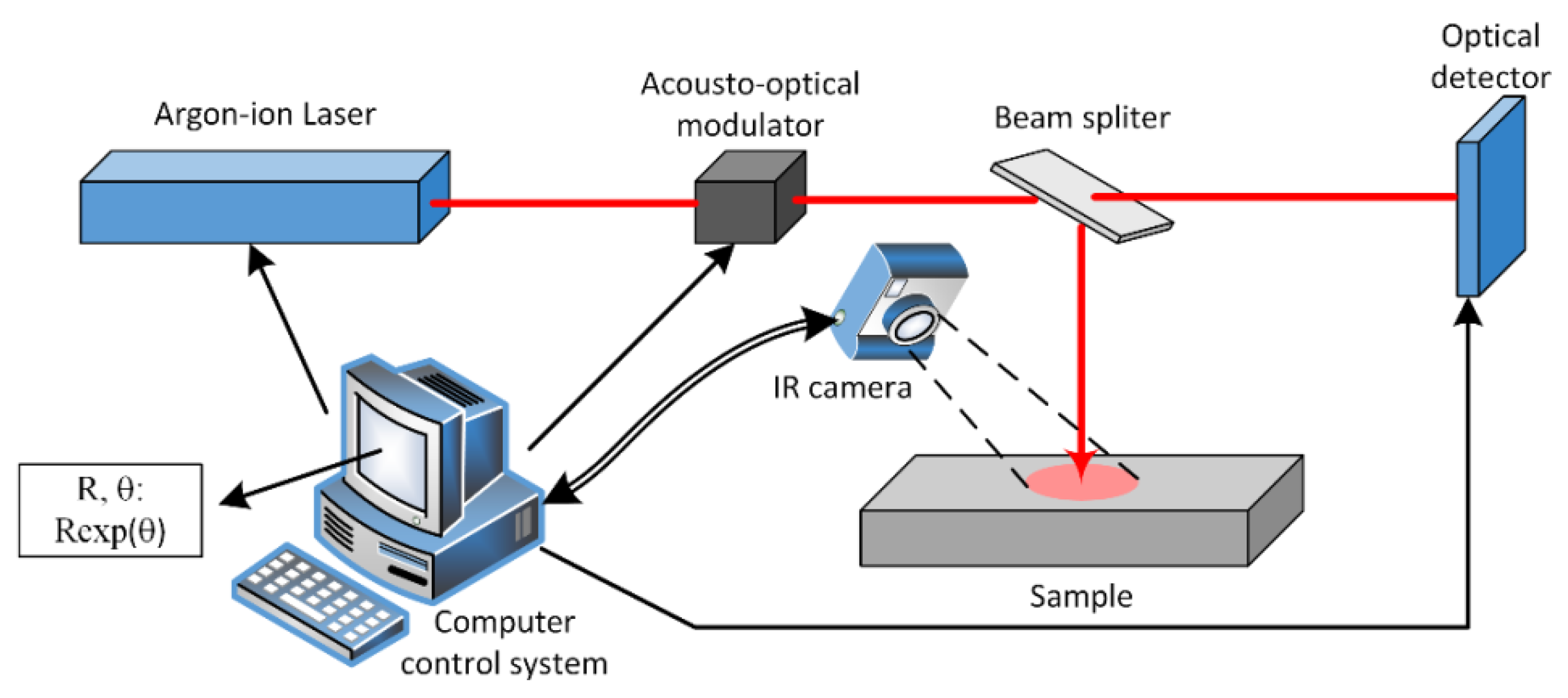
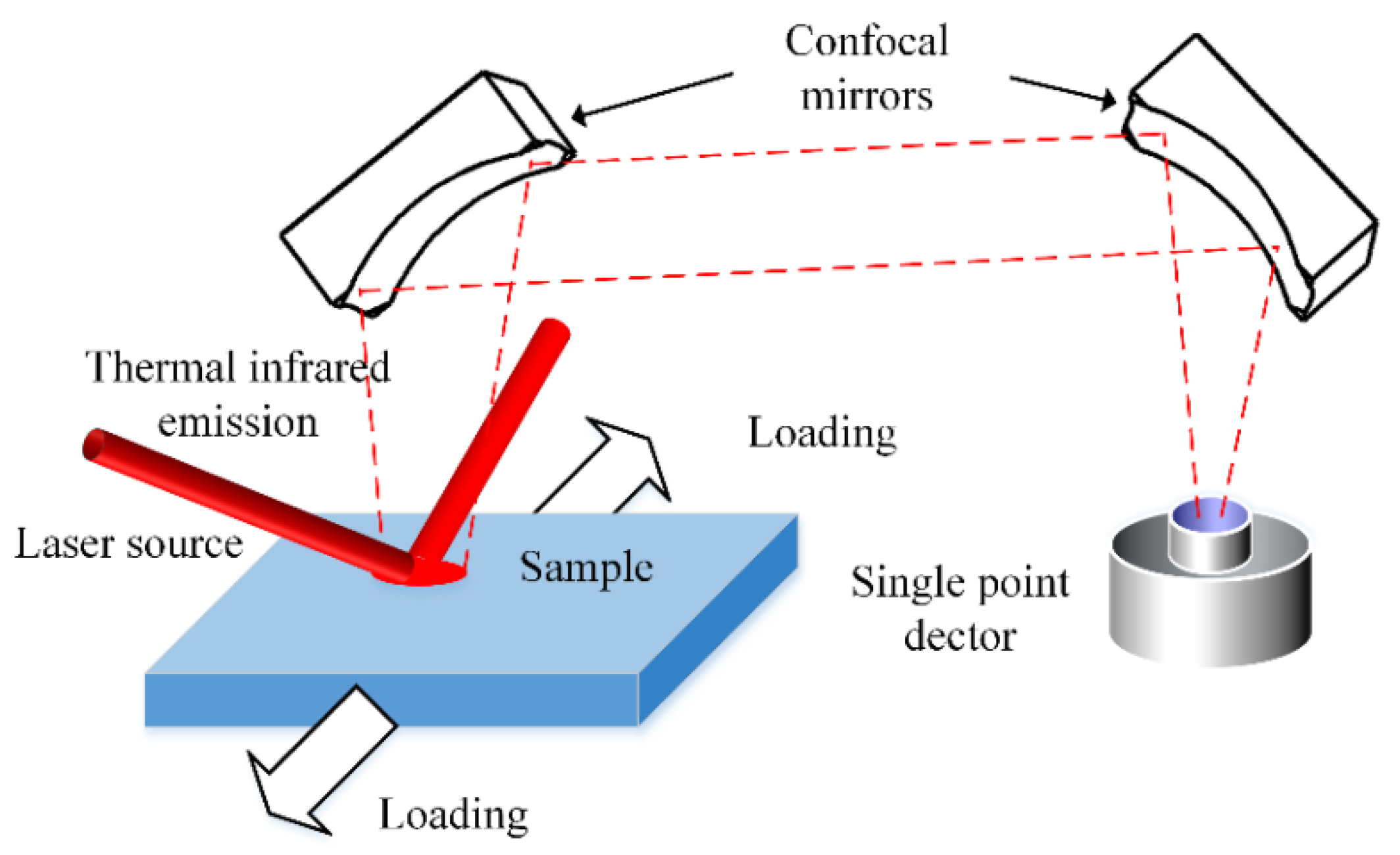
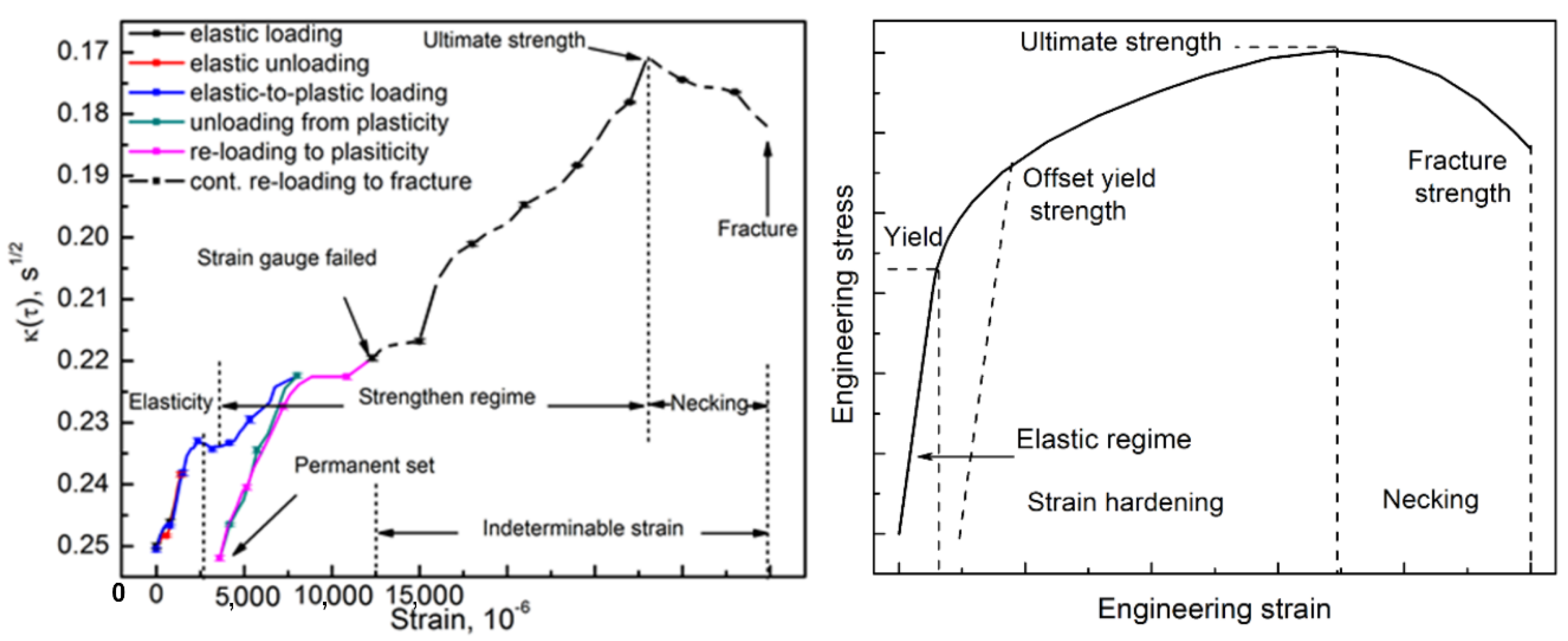
| Category | Methodology | Physical Field | System Complexity | Contact/Non-Contact | Measurement Range |
|---|---|---|---|---|---|
| Optical/radiative | DIC | Electromagnetic | Low | Non-contact | Surface only |
| X-ray | Electromagnetic | High | Non-contact | Internal | |
| Acoustic | Pure acoustic | Elastic | Low | Contact | Surface/internal |
| PA | Thermoelastic | Medium | Semi-/total-noncontact | Surface/internal | |
| Thermal | SPATE | Electromagnetic | Medium | Non-contact | Average |
| PTMR | Electromagnetic | Low | Non-contact | Surface/internal |
© 2020 by the authors. Licensee MDPI, Basel, Switzerland. This article is an open access article distributed under the terms and conditions of the Creative Commons Attribution (CC BY) license (http://creativecommons.org/licenses/by/4.0/).
Share and Cite
Huan, H.; Liu, L.; Mandelis, A.; Peng, C.; Chen, X.; Zhan, J. Mechanical Strength Evaluation of Elastic Materials by Multiphysical Nondestructive Methods: A Review. Appl. Sci. 2020, 10, 1588. https://doi.org/10.3390/app10051588
Huan H, Liu L, Mandelis A, Peng C, Chen X, Zhan J. Mechanical Strength Evaluation of Elastic Materials by Multiphysical Nondestructive Methods: A Review. Applied Sciences. 2020; 10(5):1588. https://doi.org/10.3390/app10051588
Chicago/Turabian StyleHuan, Huiting, Lixian Liu, Andreas Mandelis, Cuiling Peng, Xiaolong Chen, and Jinsong Zhan. 2020. "Mechanical Strength Evaluation of Elastic Materials by Multiphysical Nondestructive Methods: A Review" Applied Sciences 10, no. 5: 1588. https://doi.org/10.3390/app10051588
APA StyleHuan, H., Liu, L., Mandelis, A., Peng, C., Chen, X., & Zhan, J. (2020). Mechanical Strength Evaluation of Elastic Materials by Multiphysical Nondestructive Methods: A Review. Applied Sciences, 10(5), 1588. https://doi.org/10.3390/app10051588





